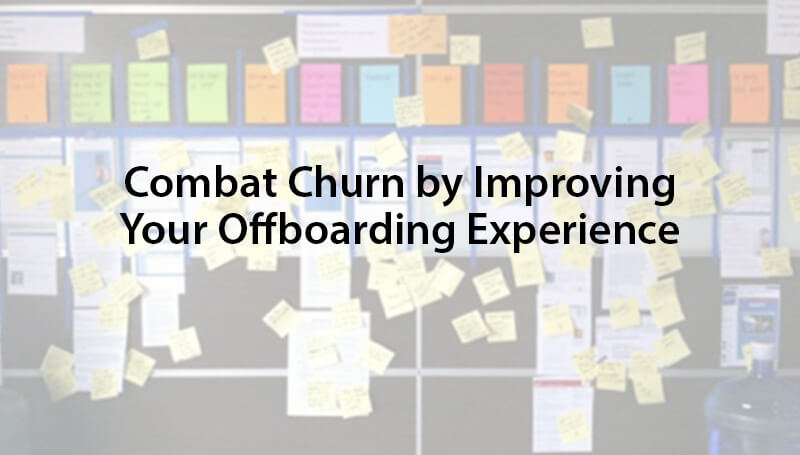Combat churn by improving your offboarding experience

.png)

.png)
You’ve invested a lot in perfecting your onboarding to drive usage and delight. Congrats! Like many SaaS companies onboarding is a hot topic (and rightfully so). Improving onboarding is mission critical for getting customers to value and ultimately reducing churn.
But when it comes to customers and revenue, a customer saved is just as valuable as a customer gained. Dollar for dollar.
Is your team so focused on onboarding you’ve turned a blind eye to churn? Uh oh! It may be inevitable that you end up with some amount of unsatisfied customers. However I’ve found that you might be losing a lot of customers unnecessarily. If you invest in designing your cancellation process with the same meticulousness you do your onboarding, you can dramatically reduce churn.
The goal of intentionally designing the offboarding process is to understand what the experience of low usage, unmet needs and eventual cancellation looks like from our customers’ perspective. Do you know what it’s like to cancel your product? What’s the story you’re telling frustrated customers who are on the brink?
In SaaS, articles and blogs about how to solve churn can get overly complex. I think of the reason people/companies churn in a very simple way, you made a claim or promise that you didn’t deliver. That’s not your customer’s problem. That’s your problem. And the solution doesn’t have to be complicated. Here’s one super low-tech way to improve your offboarding experience.
That’s right. Use paper and good ‘ol Post-it notes.
Get a small group together to map out the experience of cancelling from your customers’ perspective. Print out screens they see, the emails they get, and/or the phone call scripts from account managers. Find an open wall in your office (preferably one that’s highly visible) and document the experience for all to see! This typically accomplishes two big goals:
You’ll easily identify gaps. There’s something about seeing the end-to-end process live and in-person that makes the true “misses” really pop. You can use smaller Post-it notes to mark the gaps in the process or areas to change the process.
People may be shocked. It’s sad but true, this usually creates some confusion and frustration. Folks who are disconnected from customers or the product will want to do something to make the experience better. You can more easily drive collaboration across teams. When it’s up on a wall it becomes about the customer and not about specific departments or areas of ownership.

After mapping out the offboarding experience and identifying the gaps, you should also look for opportunities to add churn indicators. How can you get ahead of this? As Jason Lemkin shares, it’s “measuring Almost Churn. Why? Well, for every customer that churns … there’s at least another one just like them that almost would churn.” How can you track and get notified of low usage or troubled customers in advance? Consider setting up low usage triggers to notify internal teams or set up cohort reports. Helping customers get to value is the whole point.
Once you’ve created agreement and alignment about which gaps to fix, it’s time to test and implement! Some of the gaps you identified might be obvious quick fixes. Others might need testing. This might require effort from multiple departments if you’re not using a solution like Appcues. Create a project plan for each area that needs work and establish due dates. Assign owners who will collaborate across departments. And go to town!
If your challenge is adding value, you could add an e-book or white paper at strategic points in the process. Do you know why your customers are cancelling? Make it a point to automatically collect their reason for cancelling and then follow up based on their feedback.
If you’re like most Saas companies, however, the biggest changes will take place in the product. As you’re working on your roadmap or the next few releases, make sure to add the small usability fails or new features as tests in your process.
At Pure Chat, we wanted to add more value and also streamline the offboarding process. Below is one design that we tested for our product. We also automatically collect insight as to why customers cancel when they do leave. Now we can identify trends and better solve our customers’ problems with our product.

At SaaSFest earlier this month, we discussed that one cancel experience does not fit all. Just because this design has helped us at Pure Chat better understand why customers cancel and chip away at churn, doesn’t mean that it will work for your company. The goal is to learn from the offboarding process, design it intentionally, and use it to improve your product.
Have you tested any offboarding experiences in your product? What’s worked to minimize churn? Share what you’ve learned! I’d love to learn from your experiences, too.
Lindsay Bayuk does product at Pure Chat–a live chat software company focused on small business lead capture. She is a product management and product marketing geek. Lindsay is passionate about technology, marketing, entrepreneurship, and is an avid connector. Previously she led the core product management and product marketing teams at Infusionsoft. Before moving into product at Infusionsoft she was part of the marketing team at WebPT. She lives in Phoenix, Arizona, and in her free time (likely with iPhone in hand) you can find her taking in cultural and culinary delights. Connect with her @lindsaybayuk.